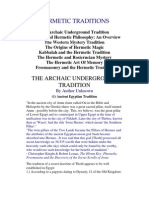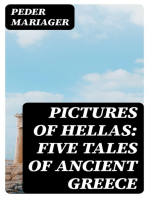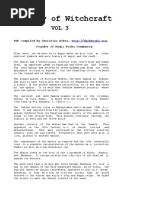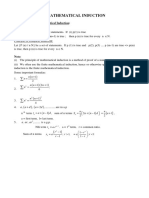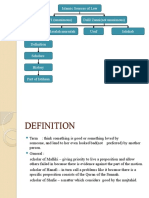Nekyia
Nekyia
Uploaded by
nieotyagiCopyright:
Available Formats
Nekyia
Nekyia
Uploaded by
nieotyagiCopyright
Available Formats
Share this document
Did you find this document useful?
Is this content inappropriate?
Copyright:
Available Formats
Nekyia
Nekyia
Uploaded by
nieotyagiCopyright:
Available Formats
9/25/13
Nekyia - Wikipedia, the free encyclopedia
In ancient Greek cult-practice and literature, a nekyia ( ) is a "rite by which ghosts were called up and questioned about the future," i.e., necromancy. A nek yia is not necessarily the same thing as a k atabasis . While they both afford the opportunity to converse with the dead, only a k atabasis is the actual, physical journey to the underworldundertaken by several heroes in Greek and Roman myth. In common parlance, however, the term "nekyia" is often used to subsume both types of event, so that by Late Antiquity for example "Olympiodorus ... claimed that three [Platonic] myths were classified as nekyia (an underworld story, as in Homer's Odyssey book 11)".[1]
Contents [hide] 1 Questioning ghosts 2 The Odyssey 3 Jung 3.1 Night sea-journey 4 Cultural references 5 See also 6 References
Questioning ghosts
[edit source]
A number of sites in Greece and Italy were dedicated wholly or in part to this practice. "The Underworld communicated with the earth by direct channels. These were caverns whose depths were unplumbed, like that of Heraclea Pontica."[2] The most notable was theNecromanteion in the northwestern Greek town of Ephyra. Other oracles of the dead could be found at Taenaron and Avernus. Such specialized locations, however, were not the only places necromancy was performed. One could also perform the rite at a tomb, for example. Among the gods associated with the nek yia rite are Hades, his wife Persephone, Hecate, and Hermes (in his capacity as psychopompus one who escorted souls to Hades).
The Odyssey
[edit source]
The earliest reference to this cult practice comes from Book 11 of the Odyssey, which was called the Nek yia in Classical antiquity. Odysseus was instructed to "make a journey of a very different kind, and find your way to the Halls of Hades ... across the River of Ocean".[3]There he consults the soul of the priest and prophet Teiresias about the means to return home to Ithaca, in a setting of "ghosts and dark blood and eerie noises, like a canvas ofHieronymous Bosch".[4] He sacrifices a ram and an ewe so that "the countless shades of the dead and gone" would "surge around" him[5] and then he meets and talks to the souls of the dead. "The story of Odysseus's journey to Hades ... was followed ... by further accounts of such journeys undertaken by other heroes", although it is clear that, for example, "the [k atabasis , "descent"] of Herakles in its traditional form must have differed noticeably from the Nekyia".[6] The Athenian playwright Aeschylus features the use of tombside nek yiai in his Persians andLibation Bearers .
Jung
[edit source]
C. G. Jung used the concept of Nekyia as an integral part of his analytical psychology: "Nekyia ... introversion of the conscious mind into the deeper layers of the unconscious psyche".[7] For Jung, "the Nekyia is no aimless or destructive fall into the abyss, but a meaningful k atabasis ... its object the restoration of the whole man".[8] Jolande Jacobi added that "this 'great Nekyia' ... is interwoven with innumerable lesser Nekyia experiences".[9]
en.wikipedia.org/wiki/Nekyia#Jung 1/2
9/25/13
Nekyia - Wikipedia, the free encyclopedia
Night sea-journey
[edit source]
Jung used the images of the Nekyia, of "the night journey on the sea ... descend into the belly of the monster (journey to hell)", and of "'Katabasis' (descent into the lower world)"[10]almost interchangeably. His closest followers also saw them as indistinguishable metaphors for "a descent into the dark, hot depths of the unconscious ... a journey to hell and 'death'" emphasising for example that "the great arc of the night sea journey comprises many lesser rhythms, lesser arcs on the same 'primordial pattern'",[11] just like the nekyia. The post-Jungian James Hillman however made some clear distinctions among them: The descent of the underworld can be distinguished from the night sea-journey of the hero in many ways the hero returns from the night sea-journey in better shape for the tasks of life, whereas the nekyia takes the soul into a depth for its own sake so that there is no "return." The night sea-journey is further marked by building interior heat (tapas), whereas the nekyia goes below that pressured containment, that tempering in the fires of passion, to a zone of utter coldness ... The devil image still haunts in our fears of the unconscious and the latent psychosis that supposedly lurks there, and we still turn to methods of Christianism moralizing, kind feelings, communal sharing, and childlike naivete as propitiations against our fear, instead of classical descent into it, the nekyia into imagination (Only) after his nekyia, Freud, like Aeneas (who carried his father on his back), could finally enter "Rome".[12]
Cultural references
[edit source]
"Thomas Mann's conception of the nekyia draws extensively from 'the doctrines of the East...Gnosticism, and Hellenism'".[13] Jung considered Picasso's "early Blue Period ... as the symbol of Nekya, a descent into hell and darkness".[14] Nek yia is also a popular name assumed by numerous art projects and performance or music groups.[citation needed]
en.wikipedia.org/wiki/Nekyia#Jung
2/2
You might also like
- MacLACHLAN Persephone As KoreDocument10 pagesMacLACHLAN Persephone As Koremegasthenis1No ratings yet
- Moral RelativismDocument5 pagesMoral RelativismnieotyagiNo ratings yet
- Is Present Reality: The Super-Science of the Transcendental ValueFrom EverandIs Present Reality: The Super-Science of the Transcendental ValueNo ratings yet
- Tears in the Desert: Lessons from the Joys and Sorrows of God’S CallFrom EverandTears in the Desert: Lessons from the Joys and Sorrows of God’S CallNo ratings yet
- The Mistletoe Murders: A Nietzschean Murder MysteryFrom EverandThe Mistletoe Murders: A Nietzschean Murder MysteryRating: 5 out of 5 stars5/5 (1)
- Katabasis Topography of ComaDocument13 pagesKatabasis Topography of ComaTimothy SmithNo ratings yet
- To Lock of EleusisDocument37 pagesTo Lock of EleusisTeatro RelacionalNo ratings yet
- Katabasis: A Trip To The CoastDocument3 pagesKatabasis: A Trip To The CoastVILLARBA, DarizNo ratings yet
- Hermetic TraditionsDocument90 pagesHermetic TraditionsTony Black100% (1)
- GGDocument3 pagesGGDaniel oluwamuyiwaNo ratings yet
- Ancient Egyptian Conception of The SoulDocument9 pagesAncient Egyptian Conception of The Soulg711kNo ratings yet
- Running Head: The Bacchae: Euripides' Critical Portrayal of The Cult of Dionysus 1Document20 pagesRunning Head: The Bacchae: Euripides' Critical Portrayal of The Cult of Dionysus 1VamehaNo ratings yet
- Archaic Mysteries of Ecstasy, K. MomrakDocument36 pagesArchaic Mysteries of Ecstasy, K. Momrakbiologypassers0hNo ratings yet
- Zorba DanceDocument11 pagesZorba DanceAlexandru Ionut CatoiNo ratings yet
- Ray: Blessed Mysteries: GleamingDocument18 pagesRay: Blessed Mysteries: Gleamingztanga7@yahoo.comNo ratings yet
- 05.suarez de La Torre (Rev.)Document24 pages05.suarez de La Torre (Rev.)est1949No ratings yet
- Hermes Trismegistus: The Archaic Underground TraditionDocument8 pagesHermes Trismegistus: The Archaic Underground TraditionavisenicNo ratings yet
- "Preparations For A Structuralist Study of Cannibalism in Greek Myth" P. Winston FettnerDocument8 pages"Preparations For A Structuralist Study of Cannibalism in Greek Myth" P. Winston Fettnerapi-231073383No ratings yet
- The Orphic Mysteries - Godwin PDFDocument5 pagesThe Orphic Mysteries - Godwin PDFAlkimistNo ratings yet
- Sorcery Among Powerless CorpsesDocument11 pagesSorcery Among Powerless CorpsesEve AthanasekouNo ratings yet
- The Taoist "Soul" Is Like A Drop of Water in A StreamDocument24 pagesThe Taoist "Soul" Is Like A Drop of Water in A StreamMhel Hugable TeddyNo ratings yet
- The Eternal Return: Oedipus, The Tempest, Forbidden Planet: Tales of the Mythic World, #2From EverandThe Eternal Return: Oedipus, The Tempest, Forbidden Planet: Tales of the Mythic World, #2Rating: 1 out of 5 stars1/5 (1)
- Paul Bishop, Terence Dawson, Leslie Gardner - The Descent of The Soul and The Archaic - Katábasis and Depth Psychology-Routledge (2022)Document249 pagesPaul Bishop, Terence Dawson, Leslie Gardner - The Descent of The Soul and The Archaic - Katábasis and Depth Psychology-Routledge (2022)patrickaboisNo ratings yet
- Suarez, Emilio - Dionisios ApolloDocument24 pagesSuarez, Emilio - Dionisios ApolloGinaNo ratings yet
- An Archetypal ApproachDocument5 pagesAn Archetypal ApproachShawn LeeNo ratings yet
- 28 1cleggDocument9 pages28 1cleggKATPONSNo ratings yet
- The Orphic Mysteries, Joscelyn Godwin PH DDocument5 pagesThe Orphic Mysteries, Joscelyn Godwin PH DFaith Lenor100% (1)
- Anti (Mythology) : ReferencesDocument6 pagesAnti (Mythology) : ReferencesdrvolkangedikNo ratings yet
- The Egyptian SecretDocument8 pagesThe Egyptian Secretbde_gnas100% (1)
- The Mysterious Eleusinian Mysteries Part 2Document12 pagesThe Mysterious Eleusinian Mysteries Part 2tarek elagamyNo ratings yet
- MythopoeiaDocument9 pagesMythopoeiaEnescu MarianNo ratings yet
- Placing The HolyDocument17 pagesPlacing The HolyThomas BayNo ratings yet
- History of Witchcraft: PDF Compiled by Christina Debes,, Founder of Magic Books CommunityDocument4 pagesHistory of Witchcraft: PDF Compiled by Christina Debes,, Founder of Magic Books CommunityDarcy ReedNo ratings yet
- Literatur Der Kult Des DionysusDocument11 pagesLiteratur Der Kult Des Dionysusschnuppe309No ratings yet
- CiklopDocument11 pagesCiklopMaja MajaNo ratings yet
- On The Centrality of Dionysus in Nietzsche's Philosophy: Ieran TewartDocument12 pagesOn The Centrality of Dionysus in Nietzsche's Philosophy: Ieran TewartMarko SlavičekNo ratings yet
- Apollonian and DionysianDocument4 pagesApollonian and DionysianMarie PoitierNo ratings yet
- DaimonDocument5 pagesDaimonjasphy26No ratings yet
- Iasil JapanDocument10 pagesIasil JapanfrancoissurprenantNo ratings yet
- Daniel SCAVONE Joseph of Arimathea The Holy Grail and The Edessa IconDocument25 pagesDaniel SCAVONE Joseph of Arimathea The Holy Grail and The Edessa IconLetras ConvidaNo ratings yet
- Egyptian LiteratureDocument18 pagesEgyptian LiteratureLovely TobesNo ratings yet
- Ghosts in LiteratureDocument2 pagesGhosts in LiteratureaanndmaiaNo ratings yet
- Project Muse 374646Document15 pagesProject Muse 374646Daniel LourençoNo ratings yet
- The Labyrinth and The Green ManDocument13 pagesThe Labyrinth and The Green ManAlex Arango Valencia100% (1)
- Patron of SorceryDocument3 pagesPatron of SorceryricklffNo ratings yet
- Anunnaki Nephilim: (Willy Schrodter, Commentaries On The Occult Philosophy of Agrippa)Document4 pagesAnunnaki Nephilim: (Willy Schrodter, Commentaries On The Occult Philosophy of Agrippa)niko100% (1)
- 2020 JAEI 25anubisdemonDocument11 pages2020 JAEI 25anubisdemonagustinNo ratings yet
- Myth As ThoughtDocument4 pagesMyth As Thoughtkiere VillanuevaNo ratings yet
- Psyche and Soma A Jungian Inquiry Into TDocument15 pagesPsyche and Soma A Jungian Inquiry Into Tdimos dimakopoulosNo ratings yet
- The Demonic Lore of Ancient Egypt Quest PDFDocument42 pagesThe Demonic Lore of Ancient Egypt Quest PDFAankh Benu100% (1)
- The Hidden Life in FreemasonryDocument8 pagesThe Hidden Life in Freemasonrydevpriya kumarNo ratings yet
- Lesson 2 - MythoDocument18 pagesLesson 2 - MythoBrixylle AnneNo ratings yet
- A Personal Endowment The Descent Journey PDFDocument43 pagesA Personal Endowment The Descent Journey PDFMauricio Toledo Piza LopesNo ratings yet
- Platos X and Hekates Crossroads Astronom PDFDocument8 pagesPlatos X and Hekates Crossroads Astronom PDFVeštičja revija100% (1)
- Clarke, 1981. Homer's Readers A Historical Introduction To The Iliad and The Odyssey, Newark, 60-105.Document5 pagesClarke, 1981. Homer's Readers A Historical Introduction To The Iliad and The Odyssey, Newark, 60-105.PerseusAusKitiumNo ratings yet
- Four Hun Dred Centuries Cave Art: The Cradle of HumanityDocument1 pageFour Hun Dred Centuries Cave Art: The Cradle of Humanityjan mullerNo ratings yet
- Divine Wheels HF Submitted 03.03.2022 Edited at HadeanDocument11 pagesDivine Wheels HF Submitted 03.03.2022 Edited at HadeanMary Carmen RodriguezNo ratings yet
- Xenakis' Mythical ThinkingDocument7 pagesXenakis' Mythical ThinkingMar GNo ratings yet
- Movie Ulysses 1954 Review The Movie Is Inspired in TheDocument6 pagesMovie Ulysses 1954 Review The Movie Is Inspired in TheLeo Licuanan BasayaNo ratings yet
- The Child-Murdering Mother: Dionysian or Apollonian? A Study of Nietzsche S View On Euripidean TragedyDocument6 pagesThe Child-Murdering Mother: Dionysian or Apollonian? A Study of Nietzsche S View On Euripidean TragedyAyeNo ratings yet
- Self Determination TheoryDocument13 pagesSelf Determination Theorynieotyagi100% (1)
- Epiphany (Feeling)Document2 pagesEpiphany (Feeling)nieotyagiNo ratings yet
- Executive FunctionsDocument9 pagesExecutive FunctionsnieotyagiNo ratings yet
- Elaboration Likelihood ModelDocument3 pagesElaboration Likelihood ModelnieotyagiNo ratings yet
- Rational Choice TheoryDocument6 pagesRational Choice TheorynieotyagiNo ratings yet
- Emotional ContagionDocument4 pagesEmotional ContagionnieotyagiNo ratings yet
- Speech ActDocument6 pagesSpeech ActnieotyagiNo ratings yet
- Lateral ThinkingDocument2 pagesLateral ThinkingnieotyagiNo ratings yet
- Stream of Consciousness (Psychology) ADocument1 pageStream of Consciousness (Psychology) AnieotyagiNo ratings yet
- Creativity TechniquesDocument2 pagesCreativity TechniquesnieotyagiNo ratings yet
- Creative WritingDocument4 pagesCreative WritingnieotyagiNo ratings yet
- Self-Knowledge (Psychology)Document10 pagesSelf-Knowledge (Psychology)nieotyagiNo ratings yet
- SentienceDocument3 pagesSentiencenieotyagiNo ratings yet
- Impairment: Acute Self-AwarenessDocument1 pageImpairment: Acute Self-AwarenessnieotyagiNo ratings yet
- Creative Problem SolvingDocument3 pagesCreative Problem Solvingnieotyagi100% (1)
- Self-Concept - Wikipedia, The Free EncyclopediaDocument7 pagesSelf-Concept - Wikipedia, The Free Encyclopedianieotyagi100% (1)
- Mental ModelDocument6 pagesMental ModelnieotyagiNo ratings yet
- History of The Term: Nous Intelligere. IntellectusDocument10 pagesHistory of The Term: Nous Intelligere. IntellectusnieotyagiNo ratings yet
- History of The Term: Nous Intelligere. IntellectusDocument10 pagesHistory of The Term: Nous Intelligere. IntellectusnieotyagiNo ratings yet
- Domain KnowledgeDocument1 pageDomain KnowledgenieotyagiNo ratings yet
- نقد الترجمة الدينية - معايرة ترجمتين للتهكم في القرآن الكريمDocument25 pagesنقد الترجمة الدينية - معايرة ترجمتين للتهكم في القرآن الكريمyasmin alshamNo ratings yet
- SP Speaks Out 'Are HK Devotees Parasites'Document2 pagesSP Speaks Out 'Are HK Devotees Parasites'Sourav PunoriaNo ratings yet
- 1 PBDocument8 pages1 PBFatikaguruNo ratings yet
- 120 Minutes: Pamela Moll Flanders Tristram Shandy ShamelaDocument14 pages120 Minutes: Pamela Moll Flanders Tristram Shandy ShamelarajeshNo ratings yet
- Inclusive Summer CampDocument122 pagesInclusive Summer Campapi-386369765No ratings yet
- Let Us Fix Our Eyes On Jesus: Hebrews 12:1-29Document43 pagesLet Us Fix Our Eyes On Jesus: Hebrews 12:1-29Roselle G. MalanaNo ratings yet
- PPT2 Teaching of LitDocument22 pagesPPT2 Teaching of Litmra27 natividadNo ratings yet
- SNAP ReasoningDocument125 pagesSNAP ReasoningAnirban Mitra100% (1)
- Vocabulary Extra Unit 2Document3 pagesVocabulary Extra Unit 2MariaInesMartinefskiNo ratings yet
- Inter 1st Year Maths IA Mathematical - InductionDocument10 pagesInter 1st Year Maths IA Mathematical - InductiontmbloodoxygenNo ratings yet
- Teammate It-OverviewDocument32 pagesTeammate It-OverviewRhea SimoneNo ratings yet
- Sniffing Network Traffic in PythonDocument27 pagesSniffing Network Traffic in PythonnarendraNo ratings yet
- Year 4 Cefr Writing LPDocument2 pagesYear 4 Cefr Writing LPeidda74No ratings yet
- AADocument24 pagesAAjanaki76% (29)
- Ethnologue: Filipino (Document1 pageEthnologue: Filipino (hhii aasdasdNo ratings yet
- Sales StrategyDocument60 pagesSales StrategySandip NayekNo ratings yet
- Discrete Applied Mathematics: John Mccoy, Michael A. HenningDocument13 pagesDiscrete Applied Mathematics: John Mccoy, Michael A. HenningPrem Kishore.Ph.D.ScholarNo ratings yet
- Quarter4 AssertionsDocument36 pagesQuarter4 AssertionsJodi SaligumbaNo ratings yet
- SAP Wage TypesDocument4 pagesSAP Wage TypesSanjay MuralidharanNo ratings yet
- Term Paper Manipulation of Emotions in Orwell's Shooting An ElephantDocument5 pagesTerm Paper Manipulation of Emotions in Orwell's Shooting An ElephantsadiasarminNo ratings yet
- Data Comm CT SolDocument3 pagesData Comm CT SolDeepikaVelivelaNo ratings yet
- GMAT EnglishDocument6 pagesGMAT Englishsamar RamadanNo ratings yet
- Her Reply A Hit PoemDocument10 pagesHer Reply A Hit PoemArbenson CNo ratings yet
- Tieng Anh 8 Friends Plus - Word Form - Unit 6Document2 pagesTieng Anh 8 Friends Plus - Word Form - Unit 6Nguyễn LongNo ratings yet
- NAHL PUBLIC SCHOOL Eng 1st YearDocument3 pagesNAHL PUBLIC SCHOOL Eng 1st YearFayyaz AhmedNo ratings yet
- Cuadernillo Ingles 1er AñoDocument16 pagesCuadernillo Ingles 1er Añocristian german arce pereaNo ratings yet
- Animal Habitats Text SetDocument36 pagesAnimal Habitats Text Setapi-314220857No ratings yet
- Pinkfong Wonderstar - Sing-Along Concert - PINKFONG Wiki - FandomDocument5 pagesPinkfong Wonderstar - Sing-Along Concert - PINKFONG Wiki - FandomchefchadsmithNo ratings yet
- Islamic Sources of Law Dalil Qat'I (Unanimous) Dalil Zanni (Not Unanimous) Istihsan Istishab Uruf Masalah MursalahDocument9 pagesIslamic Sources of Law Dalil Qat'I (Unanimous) Dalil Zanni (Not Unanimous) Istihsan Istishab Uruf Masalah MursalahUstaz Mohammad Iman TalibNo ratings yet
- Pop Ico Erp Invoic - Invoic02 2Document23 pagesPop Ico Erp Invoic - Invoic02 2Karim MezianiNo ratings yet








